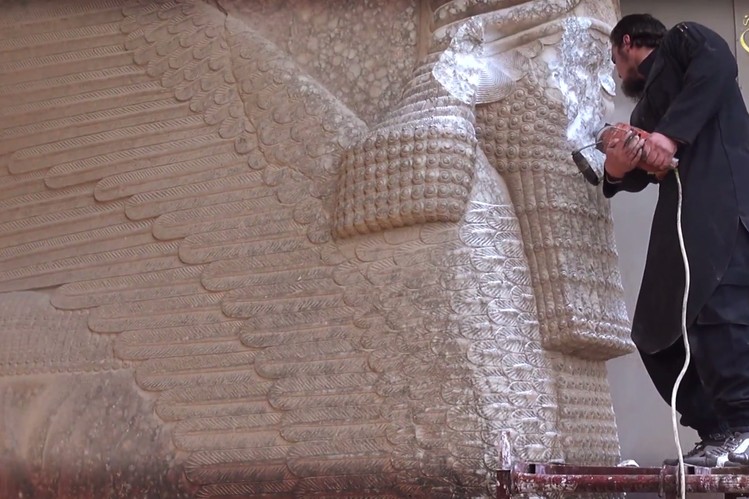The Destruction of Cultural Heritage Should be a War Crime

The world has changed; the law must change with it
By
It turns out that the news isn’t as bad as it first appeared. On Thursday, Islamic State posted a five-minute video of men destroying ancient Mesopotamian sculptures in the Mosul Museum, Iraq’s second-largest museum, with sledgehammers and power tools. Their stated reason was that these works of art promoted idolatry. It was a sickening sight—more than one person I know couldn’t bear to watch the footage—and quickly elicited public denunciations from cultural leaders such as Thomas P. Campbell, director of New York’s Metropolitan Museum of Art, and Unesco Director-General Irina Bokova.
But later that day a University College, London archaeologist told Britain’s Channel 4 News that the metal reinforcing bars visible poking out of some of the fragments lying on the floor indicated that some of the targeted statues were plaster replicas of works that had previously been evacuated to the Baghdad Museum for safekeeping.
Not all were copies, however. The video shows the vandals systematically demolishing one (or possibly more) of the monumental human-headed, winged bull deities dating from the ninth century B.C. that had once guarded the entrance to the Assyrian king’s palace. These works (fortunately other examples can be seen in several Western museums) are some of the greatest achievements in early monumental sculpture, outstripping even those of ancient Egypt in beauty, technical accomplishment and psychological power.
Still, this narrow escape is cold comfort considering that, just days before, Islamic State had burned down the Mosul library, eradicating thousands of rare books and manuscripts. And, for months, Islamic State has been burning churches and Muslim shrines, destroying tombs and pillaging archaeological sites for booty it can sell on the black market to fund its operations.
Nor is this rampage confined to Islamic State. A few years ago Malian jihadists destroyed mud tombs and some of the ancient Islamic manuscripts in Timbuktu, and in 2001 the Taliban in Afghanistan blew up the two colossal statues of Buddha in Bamiyan.
So far the world has watched this spectacle with a growing sense of helplessness and alarm. The patchwork of responses from governments, agencies and individuals has consisted in the main of trying to protect endangered objects and sites, prevent their destruction, and document instances where protective efforts have failed. Some of these actions have required great personal courage. But in the face of vandalism on this scale and at this level of wantonness and depravity, something larger is called for. The collective voice of the civilized world must speak out and declare that, henceforth, the destruction of cultural heritage will be deemed a war crime, with appropriate penalties meted out by the International Court of Justice in The Hague.
This is not the first time cultural heritage has been targeted. The Nazis famously expropriated the art holdings and other personal property of Jews as part of the Final Solution and looted Europe’s public collections to create a supermuseum in Hitler’s hometown of Linz, Austria. As the Allies approached Paris, Hitler tried to have Notre Dame and the city’s other historic monuments blown up. Fortunately, his military governor refused to carry out the order.
But this case is different. Other than that last spasm involving Paris, Hitler’s aim with respect to art and artifacts was not to destroy but to acquire. By contrast Islamic State is waging a war on cultural heritage that makes a mockery of existing protections enshrined in law.
The operative document here is the United Nations’ 1954 Hague Convention. It prohibits using monuments and sites for military purposes and harming or misappropriating cultural property in any way. The presence of a distinctive blue shield indicates cultural property placed under the Convention’s protection.
But a blue shield wouldn’t have done anything for the Mosul Museum. A U.N. document that prohibits targeting cultural heritage is powerless in the face of nonstate actors dedicated to doing exactly that. The laws of war were changed after World War II in response to the genocidal impulses of the Nazis—the 1945 London Convention introduced the concept of “crimes against humanity.” Today they need to be changed again in hopes of stopping the current onslaught, or at least preventing subsequent ones.
Some might argue that it would diminish the moral force of a concept like crimes against humanity to include inanimate objects in the same law. In fact, they already are included. The London Convention prohibits “plunder of public or private property, wanton destruction of cities, towns or villages, or devastation not justified by military necessity.” Updating it now to mention cultural heritage specifically would simply make an implied protection explicit, bringing existing intentions in line with current realities.
More broadly, we need to recognize just what is at stake here. Cultural heritage is more than pretty objects lined up in a museum or tourist sites to visit on a vacation. It is at once a record of our shared past, a way of understanding ourselves and each other, and the product of the best part of ourselves. Its destruction is an attack on history, identity and civilization. Nothing is more important than a human life but, before the bar of our collective conscience, that should count for something too.
—Mr. Gibson is the Journal’s Arts in Review editor.









